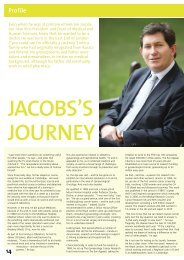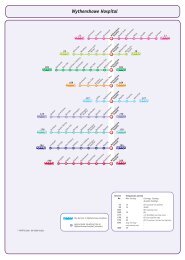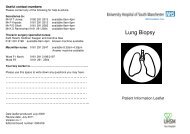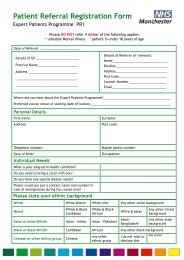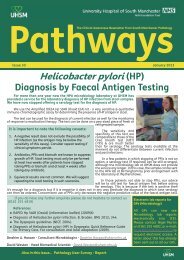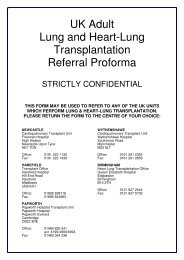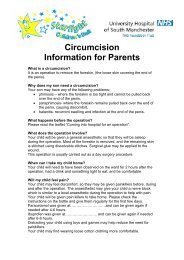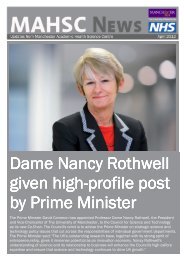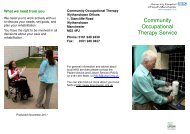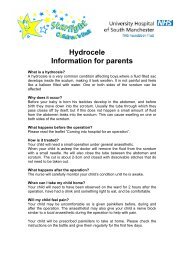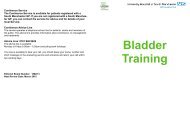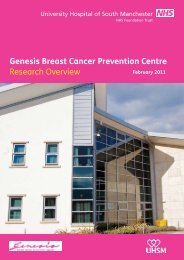A New Beginning 2012-7 - UHSM
A New Beginning 2012-7 - UHSM
A New Beginning 2012-7 - UHSM
You also want an ePaper? Increase the reach of your titles
YUMPU automatically turns print PDFs into web optimized ePapers that Google loves.
The skin layers will begin to heal very quickly and top layers are usually healed sufficiently within<br />
48 hours. They will continue to heal across the full depth of the wound for at least a further six<br />
weeks or more. As the wound heals, the scar shrinks to a thin white line. Occasionally it can<br />
remain red for a long time.<br />
It is vitally important that you look after your surgical wounds once you get home. You should<br />
report immediately, to your nurse or GP, if you notice any of the following symptoms:<br />
• increased pain – as the wounds heal the pain should decrease steadily<br />
• discharge (leakage)<br />
• increased redness/tenderness – the skin around the wound edges should be healthy<br />
in appearance<br />
• swelling<br />
• itching.<br />
At first we will help you to wash yourself but you will be encouraged to become independent as<br />
soon as possible. It is important to keep your wounds clean. A warm daily bath or shower will<br />
keep your wounds clean and encourage healing. Avoid strong perfumed soaps as they can<br />
cause irritation. Do not use flannels on wounds as they can harbour bacteria and can actually<br />
infect wounds. Use either your hand or a disposable cloth to wash the wound. If you need to<br />
touch your wounds make sure you wash your hands first and then afterwards to avoid<br />
contamination with unseen germs.<br />
Going home<br />
You will be able to go home when the doctor thinks you are medically fit.<br />
When you go home, a relative or friend should collect you from the ward. The nursing staff can<br />
give you a sickness certificate covering your stay in hospital.<br />
In most modern day cars, front airbags are standard. In the event of an accident, activation of an<br />
airbag could cause considerable harm to your chest. It is therefore not advisable to sit in the<br />
front passenger seat for the first six weeks.<br />
Medication<br />
A pharmacist or pharmacy technician will sort through any medication you bring into hospital.<br />
When you leave hospital you will be given at least one week’s supply of medication to take<br />
home. Your nurse or pharmacist will explain how and why to take your tablets before you are<br />
discharged. You will be given a copy of the discharge prescription for your own records. Your<br />
GP will prescribe your medication from there on. Continue to take your prescribed medication<br />
until you are told not to, either at the out-patient clinic, or by your GP. If you have supplies of<br />
your medication at home and are unsure whether you are still to take them, ask your GP or local<br />
pharmacist (chemist).<br />
Following surgery, you will find that your medication will be altered. Angina medication such as<br />
Isosorbide Mononitrate, and Nicorandil (Ikorel) will be stopped. However, medicines for other<br />
medical conditions you have will normally be restarted following your operation. The doses of<br />
these medicines might have changed so please check carefully.<br />
18<br />
Section D – Maintaining a healthy heart<br />
Risk factors associated with the development of coronary<br />
heart disease<br />
In Britain today we continue to have one of the highest rates of heart disease known in the<br />
western world. Although no single reason has been shown to cause coronary heart disease,<br />
research has shown that certain factors in a person’s lifestyle can increase the risk of getting<br />
coronary heart disease. These factors contribute to narrowing of the arteries surrounding the<br />
heart, which leads to coronary heart disease.<br />
These factors are called risk factors and generally fall into two categories; modifiable and<br />
non-modifiable. Modifiable means you can do something about them. Non-modifiable means you<br />
cannot change them. Many non-modifiable risk factors can be controlled and their effect reduced<br />
by making changes to your lifestyle.<br />
It is important to remember that some people may have many risk factors and others may have<br />
none.<br />
Modifiable risk factors<br />
Smoking<br />
Major studies show that smoking is the most significant preventable risk<br />
factor. People who smoke tobacco have twice the risk of developing<br />
coronary heart disease as those who do not. People who do not smoke<br />
but have to inhale the smoke from others (passive smoking) are also at<br />
risk of heart disease.<br />
Smoking affects the heart in many ways: There are more than 4000<br />
chemicals contained in tobacco smoke, many of which are harmful<br />
when inhaled by smokers and those around them. Smoking just three<br />
cigarettes a day doubles the risk of having a heart attack. Other main<br />
components include;<br />
Carbon monoxide. This is a poisonous, invisible gas with no smell. It is found in car exhausts,<br />
leaking gas heaters and burning cigarettes. It is carried around the body in the blood. To try and<br />
get more oxygen in, the heart beats faster and more red blood cells are produced. The heart has<br />
to work harder which increases the risk of heart attack or heart failure.<br />
Nicotine. This is the drug that causes addiction. It is very powerful and fast acting, hitting the brain<br />
in seven seconds after each drag. Nicotine appears to have minimal long term effects on health. In<br />
the short term it causes stimulation of the nervous system and an increase in blood pressure and<br />
heart rate. These return to normal after about 20 minutes (Manchester Stop Smoking Service 2007).<br />
Even if you have tried to give up before, it is worth another try. Stopping smoking dramatically<br />
reduces your risk of a heart attack and stroke. Did you know that former smokers live longer than<br />
continuing smokers, no matter what age they stop smoking, so whatever age you are, it is never<br />
too late to stop. Your chances of a heart attack or stroke reduce with every day you continue not to<br />
smoke.<br />
Nicotine Replacement Therapy (NRT) helps by providing the body with nicotine. The purpose of<br />
NRT is to take the edge off withdrawal symptoms. The nicotine provided from NRT is clean i.e. it<br />
does not contain the other 3999 chemicals found in cigarette smoke. Consequently it can now be<br />
used by smokers with cardiovascular disease. Stopping smoking is critical for those with heart<br />
disease as it can slow the progression of the disease down.<br />
35




